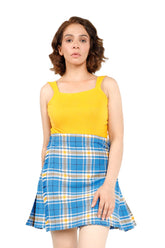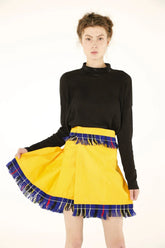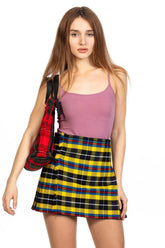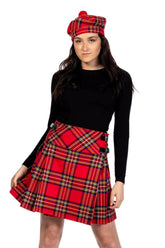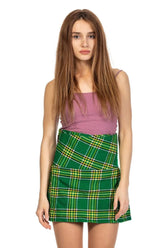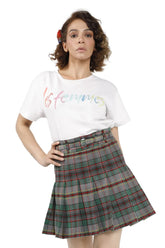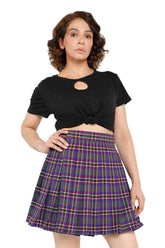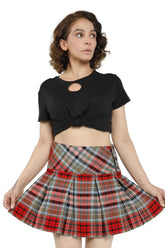Kilt vs Skirt: The Differences & Similarities
The kilt and the skirt—two garments that, at first glance, may look similar, but are rooted in very different cultures, meanings, and construction. Whether you're exploring Scottish heritage, diving into fashion history, or simply wondering is a kilt a skirt?—this article breaks down everything you need to know about the differences and similarities between kilts and skirts.
Let’s settle the kilt vs skirt conversation once and for all.
What Is a Kilt?
A kilt is a knee-length garment with pleats at the back, traditionally worn by men in Scotland. It’s most commonly made from woolen fabric in a tartan pattern, representing a clan, region, or family lineage.
But beyond style, a kilt is a symbol of Scottish pride and identity. Over the years, kilts have expanded into modern fashion, with variations like the kilt skirt for men, tartan kilted skirt, and even women’s kilt skirt options now widely available.
If you’re wondering what is a kilt, it’s best described as a structured, pleated wrap garment fastened with belts or pins—designed to stay in place, built to last, and worn with purpose.

What Defines a Skirt?
A skirt is a flexible term in fashion. It's a lower-body garment that hangs from the waist and can vary in length, fabric, fit, and style. Skirts can be mini, midi, or maxi and come in endless cuts—A-line, pencil, pleated, wrap, and more.
Skirts are globally worn by women and increasingly by men in fashion-forward or cultural contexts. Unlike kilts, skirts don’t carry a singular cultural origin, and they’re typically built with lighter materials and more variation in shape and movement.
From the tartan plaid skirt long to the classic pencil skirt, skirts offer more creative flexibility but less historical weight compared to kilts.

The Difference Between Kilt and Skirt
The difference between kilt and skirt starts with heritage. A Scottish kilt is embedded in tradition—worn during ceremonies, Highland games, weddings, and even in military dress. Skirts, on the other hand, have appeared across various cultures and are primarily associated with women’s fashion.
Calling a kilt a skirt may seem harmless, but it’s essential to understand the cultural meaning behind a kilt. That’s why some ask: is it offensive to call a kilt a skirt? In casual settings, maybe not—but in traditional Scottish circles, it can be seen as dismissive of its heritage.
Structure and Construction
A kilt is tailored and engineered, often with heavy wool, deep pleats, and secure fastenings like buckles or leather straps. Kilts are generally one-size-fitted and are worn high on the waist.
A skirt, however, is designed for variety. It may be made of cotton, polyester, silk, denim, or any lightweight fabric. Closure can be via zipper, elastic, or buttons. A kilted skirt is a hybrid—designed like a kilt but used in casual fashion, especially in kilt women's fashion.
Styling and Gender Norms
Traditionally, kilts are skirts for men—but today, they’re worn by everyone. Meanwhile, tartan skirt women outfits are all over street style and fashion blogs, especially during fall and winter.
The evolution of genderless fashion also introduces the concept of the male skirt, though in Scotland, that’s still proudly referred to as a kilt.
Can Women Wear Kilts?
Yes, absolutely. The question "do ladies wear kilts" is common—and the answer is a confident yes. While historically male-dominated, kilts have evolved into inclusive garments.
Today’s kilt options for women range from mini pleated school-style designs to full-length ceremonial pieces. The women’s kilt skirt blends structure with feminine flair and is often worn as a symbol of empowerment and fashion consciousness.
Fashion houses, street stylists, and Scottish festivals now all embrace women in kilts as part of modern design.

Similarities Between Kilts and Skirts
Despite their differences, kilts and skirts do share a few things in common:
-
Silhouette: Both are lower-body garments that offer freedom of movement.
-
Pleats: Many skirts, especially the tartan skirt women styles, feature pleating similar to kilts.
-
Materials: Wool, cotton, and blends are common in both.
-
Global Appeal: From the Scottish Skirt to runway-ready plaid ladies skirts, both are now internationally popular.
One key overlap is the rise in tartan plaid skirt long styles that mimic the look of kilts while leaning into feminine styling and length variety.
Frequently Asked Questions
Is it offensive to call a kilt a skirt?
It depends on context, tone, and audience. While the kilt and skirt may appear similar, a kilt holds deep cultural significance, especially in Scotland. Referring to it as a “skirt” in casual conversation might not be offensive, but doing so in a formal or traditional setting can be seen as disrespectful. To honor its heritage, it's best to refer to it properly as a "kilt."
What is a male skirt called?
In modern fashion, a skirt worn by a man may simply be called a “male skirt.” However, if it’s specifically rooted in Scottish heritage—pleated, wrapped, and worn with traditional accessories—it is called a kilt. The term “kilt” refers to a structured garment with cultural identity, not just a generic men’s skirt.
Can a kilt be considered a type of skirt?
Structurally, yes—a kilt is a wrap-around garment worn on the lower body, much like a skirt. However, culturally and historically, the kilt is far more specific. It follows certain construction rules, includes pleats and tartan patterns, and often symbolizes Scottish clan heritage. So while a kilt fits within the broader category of skirts, it stands apart in meaning.
Are there structural differences between a kilt and a skirt?
Absolutely. A kilt typically has deep pleats in the back, a wrap-over front, and is secured with straps or buckles—often made of heavier wool fabric. Skirts, on the other hand, vary widely in fabric, shape, and closure—ranging from elastic waists to zippers and flowing or fitted designs. Kilts follow a defined form; skirts are more flexible.
What are some popular styles of skirts?
There’s no shortage of skirt styles in modern fashion. Popular options include:
-
Pencil skirts for formal wear
-
A-line skirts for a classic silhouette
-
Pleated skirts, similar to kilts
-
Wrap skirts for casual comfort
-
Maxi skirts for a flowy, dramatic look
And of course, tartan skirts in various lengths—from mini to floor-length—for those who love plaid with a touch of tradition.
Final Thoughts
So, kilt vs skirt—what’s the verdict? While the two may share similarities in form and fashion, they serve different cultural, historical, and functional purposes.
A kilt is more than a garment—it’s a symbol of identity, pride, and tradition. A skirt, meanwhile, is a universally versatile piece of clothing worn in countless styles around the world.
Whether you’re embracing heritage with a tartan kilted skirt or styling your next look with a plaid ladies skirt, understanding the story behind what you wear adds depth to your fashion—and your voice.
